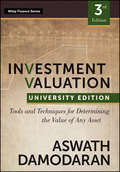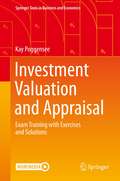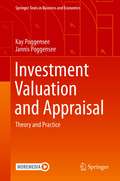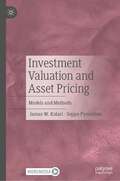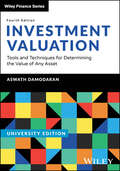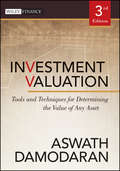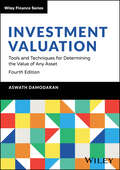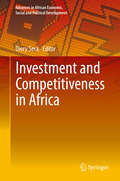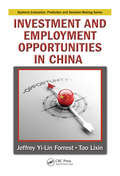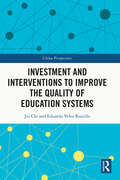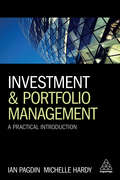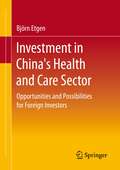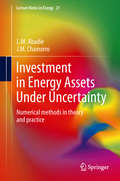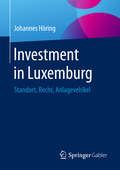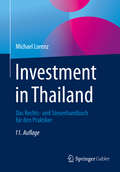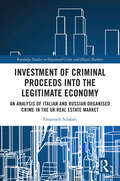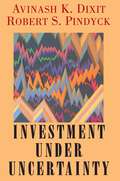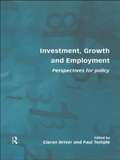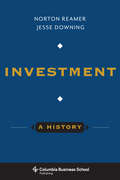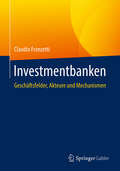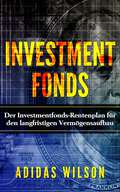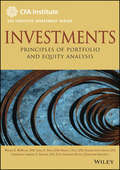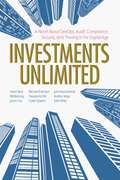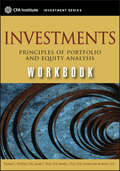- Table View
- List View
Investment Valuation
by Aswath DamodaranThe definitive source of information on all topics related to investment valuation tools and techniquesValuation is at the heart of any investment decision, whether that decision is buy, sell or hold. But the pricing of many assets has become a more complex task in modern markets, especially after the recent financial crisis. In order to be successful at this endeavor, you must have a firm understanding of the proper valuation techniques. One valuation book stands out as withstanding the test of time among students of financial markets and investors, Aswath Damodaran'sInvestment Valuation.Now completely revised and updated to reflect changing market conditions, this third edition comprehensively introduces students and investment professionals to the range of valuation models available and how to chose the right model for any given asset valuation scenario. This edition includes valuation techniques for a whole host of real options, start-up firms, unconventional assets, distressed companies and private equity, and real estate. All examples have been updated and new material has been added.An expansion of ancillaries include updated online databases, spreadsheets, and other educational support toolsFully revised to incorporate valuation lessons learned from the last five years, from the market crisis and emerging markets to new types of equity investmentsRevised examples of company valuations such as companies from Eastern Europe and Africa, which stress the global nature of modern valuationAuthor Aswath Damodaran is regarded as one of the best educators and thinkers on the topic of investment valuationThis indispensable guide is a must read for students wishing to gain a better understanding of investment valuation and its methods. With it, you can take the insights and advice of a recognized authority on the valuation process and immediately put them to work for you.
Investment Valuation and Appraisal: Exam Training with Exercises and Solutions (Springer Texts in Business and Economics)
by Kay PoggenseeThis book complements the textbook Investment Valuation and Appraisal - Theory and Practice. It contains exercises and solutions often used at academic courses about investment evaluation around the world. Using the sample solutions for the assignments, the learning progress itself can be checked by students. Thus, this book enables students of business administration to prepare for exams in self-study. In addition, it is ideal for practitioners as an illustrative object for concrete quantitative business problems and their solutions.The book covers tasks in areas such as static investment evaluation methods, dynamic investment evaluation methods, selection of alternatives and investment program planning, optimum useful lifetime and optimum replacement time and investment decisions in uncertainty. The book closes with a mock exam and its solution as is typical at universities. Solutions are shown in an Excel sheet which is available online.
Investment Valuation and Appraisal: Theory and Practice (Springer Texts in Business and Economics)
by Kay Poggensee Jannis PoggenseeThis textbook introduces readers to the most relevant aspects of Investment Evaluation in the context of enterprise evaluation. It utilises a clear didactic concept and concisely presents representative cases, supported by calculations and their step-by-step, Excel-based solutions. In addition, the book analyses the respective benefits of the calculation models discussed from a management standpoint.
Investment Valuation and Asset Pricing: Models and Methods
by James W. Kolari Seppo PynnönenThis textbook is intended to fill a gap in undergraduate finance curriculums by providing an asset pricing text that is accessible for undergraduate finance students. It offers an overview of original works on foundational asset pricing studies that follows their historical publication chronologically throughout the text. Each chapter stays close to the original works of these major authors, including quotations, examples, graphical exhibits, and empirical results. Additionally, it includes statistical concepts and methods as applied to finance. These statistical materials are crucial to learning asset pricing, which often applies statistical tests to evaluate different asset pricing models. It offers practical examples, questions, and problems to help students check their learning and better understand the fundamentals of asset pricing., alongside including PowerPoint slides and an instructor’s manual for professors.
Investment Valuation, University Edition: Tools and Techniques for Determining the Value of any Asset
by Aswath DamodaranUpdated edition of the definitive guide to investment valuation tools and techniques Investment Valuation: Tools and Techniques for Determining the Value of Any Asset delves into valuation techniques for a variety of different asset classes, including real options, start-up firms, unconventional assets, distressed companies and private equity, real estate, and many more, and explains how to choose the right model for any given asset valuation scenario. The models are presented with real-world examples so as to capture some of the problems inherent in applying these models, with discussion of differences and common elements between the models to provide readers with a holistic understanding of the subject matter. Written by a professor of finance who is widely regarded as one of the best educators and thinkers on the topic of investment valuation, this newly revised and updated Fourth Edition explores topics including: Understanding financial statements, the basics of risk, and tests and evidence for market efficiency Estimating risk parameters and costs of financing, terminal value, and equity value per share Using scenario analysis, decision trees, and simulations for probabilistic approaches in valuation Investment Valuation: Tools and Techniques for Determining the Value of Any Asset is an essential resource for all investors and students of financial markets seeking an all-in-one guide to expand their valuation knowledge and make better investment decisions.
Investment Valuation: Tools and Techniques for Determining the Value of Any Asset (Wiley Finance #666)
by Aswath DamodaranThe definitive source of information on all topics related to investment valuation tools and techniques Valuation is at the heart of any investment decision, whether that decision is buy, sell or hold. But the pricing of many assets has become a more complex task in modern markets, especially after the recent financial crisis. In order to be successful at this endeavor, you must have a firm understanding of the proper valuation techniques. One valuation book stands out as withstanding the test of time among investors and students of financial markets, Aswath Damodaran'sInvestment Valuation. Now completely revised and updated to reflect changing market conditions, this third edition comprehensively introduces investment professionals and students to the range of valuation models available and how to chose the right model for any given asset valuation scenario. This edition includes valuation techniques for a whole host of real options, start-up firms, unconventional assets, distressed companies and private equity, and real estate. All examples have been updated and new material has been added. Fully revised to incorporate valuation lessons learned from the last five years, from the market crisis and emerging markets to new types of equity investments Includes valuation practices across the life cycle of companies and emphasizes value enhancement measures, such as EVA and CFROI Contains a new chapter on probabilistic valuation techniques such as decision trees and Monte Carlo Simulation Author Aswath Damodaran is regarded as one of the best educators and thinkers on the topic of investment valuation This indispensable guide is a must read for anyone wishing to gain a better understanding of investment valuation and its methods. With it, you can take the insights and advice of a recognized authority on the valuation process and immediately put them to work for you.
Investment Valuation: Tools and Techniques for Determining the Value of Any Asset (Wiley Finance)
by Aswath DamodaranUpdated edition of the definitive guide to investment valuation tools and techniques Investment Valuation: Tools and Techniques for Determining the Value of Any Asset delves into valuation techniques for a variety of different asset classes, including real options, start-up firms, unconventional assets, distressed companies and private equity, real estate, and many more, and explains how to choose the right model for any given asset valuation scenario. The models are presented with real-world examples so as to capture some of the problems inherent in applying these models, with discussion of differences and common elements between the models to provide readers with a holistic understanding of the subject matter. Written by a professor of finance who is widely regarded as one of the best educators and thinkers on the topic of investment valuation, this newly revised and updated Fourth Edition explores topics including: Understanding financial statements, the basics of risk, and tests and evidence for market efficiency Estimating risk parameters and costs of financing, terminal value, and equity value per share Using scenario analysis, decision trees, and simulations for probabilistic approaches in valuation Investment Valuation: Tools and Techniques for Determining the Value of Any Asset is an essential resource for all investors and students of financial markets seeking an all-in-one guide to expand their valuation knowledge and make better investment decisions.
Investment and Competitiveness in Africa
by Diery SeckThe book provides a detailed analysis of the nature and determinants of finance and trade and their relationship with Africa's competitiveness. Investment is examined in its various forms (financial vs. physical), and sources (private, public, domestic and FDI), as well as its relation to the size of domestic markets and export potential. The dimensions of trade related to financial development, trade costs, development of value chains and regional integration are also studied. The capacity of finance and investment to boost Africa's competitiveness is assessed to inform continent-wide economic policy.
Investment and Employment Opportunities in China (Systems Evaluation, Prediction, and Decision-Making #9)
by Jeffrey Yi-Lin Forrest Tao LixinPresenting the most recent statistical data, Investment and Employment Opportunities in China provides first-of-its-kind coverage of the regional economic, industrial, investment, and employment structures in China. After establishing the theoretical foundation, the rest of the book utilizes the model and the methodology presented by the authors to
Investment and Growth Dynamics: An Empirical Assessment Applied to Benin
by Issouf SamakeA report from the International Monetary Fund.
Investment and Interventions to Improve the Quality of Education Systems (China Perspectives)
by Jin Chi Eduardo Velez BustilloQuality improvement is a major current goal of Education in China and this will be achieved through overall quality improvement of the education system as a whole, a situation that is also the case across the world. Deploying a cost-benefit analysis and multidisciplinary perspectives from education, economics, neurocognition, gender studies, child development, and international development, this book presents a range of critical interventions in education development and investment that have proven to be effective in many countries around the world. The book draws on theoretical and practical experience in the field of education investment and analyses key issues in China's early childhood education, early reading, girls' education, brain science application in international education, small-scale schools in low income areas and teacher education. Students and scholars of education and development and Chinese education will benefit from this title.
Investment and Portfolio Management: A Practical Introduction
by Ian Pagdin Michelle HardyFor students of finance at both undergraduate and postgraduate level, or those preparing for professional examinations, Investment and Portfolio Management develops knowledge and understanding of the key financial products, investment strategies and risks in financial markets in the UK and internationally. With an emphasis on practice, Investment and Portfolio Management presents the theory and its relevance and application in the financial workplace. The authors draw on their experience working in the financial sector to illustrate concepts with case studies, examples and problems, including material relevant to candidates studying for professional examinations offered by the major professional bodies in the subject area (Charted Institute of Investment, CII & Chartered Institute of Securities and Investment, CISI). Each chapter is written in an easy-to-follow style, allowing readers to navigate their way through different topics without issue, avoiding complicated technical jargon, in favour of simpler terms and writing style. To meet the criteria for those studying for academic and professional courses, links are provided to more in-depth material and in-chapter features to encourage self-directional learning. Online supporting resources for this book include lecture slides and figures from the book.
Investment in China's Health and Care Sector: Opportunities and Possibilities for Foreign Investors
by Björn EtgenThis reference book provides promising strategies for investing in the promising healthcare and nursing sector of the People's Republic of China. The Chinese healthcare sector is growing steadily, and the Chinese government has recognized that the participation of foreign investors is essential to improve and develop the Chinese healthcare system, especially in metropolitan areas. This opens up opportunities and possibilities for foreign healthcare providers, whose investments are increasingly welcomed and supported by the Chinese government. The book presents ways to make safe and profitable investments in the Chinese healthcare market: from the construction of new hospitals and nursing homes to the introduction of the necessary medical equipment and the acquisition and recruitment of qualified staff. In particular, the legal framework conditions are highlighted.This book is a translation of the original German 1st edition Investitionen im chinesischen Gesundheits- und Pflegesektor by Björn Etgen, published by Springer Fachmedien Wiesbaden GmbH, part of Springer Nature in 2019. The translation was done with the help of artificial intelligence (machine translation by the service DeepL.com). A subsequent human revision was done primarily in terms of content, so that the book will read stylistically differently from a conventional translation. Springer Nature works continuously to further the development of tools for the production of books and on the related technologies to support the authors.
Investment in Energy Assets Under Uncertainty
by L. M. Abadie J. M. ChamorroThis book aims to provide a rigorous yet pragmatic approach to the valuation and management of investments in the energy sector. Time and uncertainty pervade most if not all issues relevant to energy assets. They run from the early stage of prototype and demonstration to the ultimate abandonment and decommissioning. Risk in particular appears in several areas; thus, one can distinguish technical risk from financial risk. Furthermore, the extent to which one can react to them is different (just think of price risk and regulation risk). Markets in general, and financial markets in particular, regularly put a price on a number of assets which differ in their return/risk characteristics. And academia has developed sound financial principles for valuation purposes in a number of contexts. Nonetheless, the physical characteristics of the assets involved also play a key role in their valuation if only because of the restrictions that they entail. There are some instances in which the practitioner/researcher is able to come up with an analytical solution to the valuation problem. Typically, however, these instances are limited because of their relying on stylized facts or idealized frameworks. Unfortunately, many relevant instances lack analytical solutions, so one must resort to numerical methods. The book clearly explains how to implement them in a meaningful way. Their usefulness is further enhanced when numerical estimates of relevant parameters are derived from actual market prices (as long as these are available and reliable). The book starts from the basics of valuation in a dynamic, certain context. The second part then considers uncertainty and introduces a number of useful results and tools to grapple effectively with it. The last part applies these tools to the valuation of energy assets in a sequential manner, i. e. by considering one, two and three sources of risk. The last chapter provides examples of joint optimal management and value maximization in conventional power plants.
Investment in Luxemburg
by Johannes HöringDieses Buch vermittelt dem Leser einen Überblick über den Investmentstandort Luxemburg, seine Stärken und seine aktuellen Herausforderungen. Es gibt dem deutschen Anleger konkrete Handlungsempfehlungen mit auf den Weg. Dabei geht der Autor komprimiert auf die verschiedenen Themengebiete (Recht, Steuern etc.) ein.
Investment in Thailand: Das Rechts- und Steuerhandbuch für den Praktiker
by Michael LorenzDieses Buch bietet Praktikern einen essenziellen Überblick über das aktuelle thailändische Wirtschaftsrecht. Thailand gehört heute zu den wirtschaftlich attraktivsten Hubs in Südostasien und wirbt als etablierter Wirtschaftsstandort erfolgreich um Auslandsinvestitionen – mit guten Voraussetzungen für europäische Investoren.Rechtsanwalt Michael Lorenz erläutert anschaulich alle wesentlichen thailändischen Regularien, um Unternehmen, Organisationen, Investoren, Juristen und interessierten Laien rasche Orientierung bei der Klärung grundlegender rechtlicher, steuerlicher und wirtschaftlicher Fragen zu bieten. Die 11. Auflage wurde vollständig überarbeitet und auf den aktuellen Rechtsstand Januar 2019 gebracht.Darüber hinaus gibt das Werk dem Leser weiterführende Informationen an die Hand, die für westliche Investoren relevant sind, und beleuchtet interkulturelle Gegebenheiten des Wirtschaftslebens. Zahlreiche Beispiele illustrieren die Bedeutung für die Praxis.
Investment of Criminal Proceeds into the Legitimate Economy: An Analysis of Italian and Russian Organised Crime in the UK Real Estate Market (Routledge Studies in Organised Crime)
by Emanuele SclafaniThis book explores the infiltration of Italian and Russian organised crime in the UK real estate market, assessing how vulnerable the UK is to these sorts of activities. It identifies the drivers behind the criminal choices and modus operandi of Italian and Russian organised crime groups, and the factors causing their mobility abroad.Investment of Criminal Proceeds into the Legitimate Economy broadens our knowledge on the relationship between criminal agency and criminogenic opportunity in a socio-economic and legal context. This book offers a critical insight into the criminal actors and operations of Italian and Russian organised crime groups, such as money laundering schemes in the real estate sector, whilst also exploring the role of crime facilitators. Drawing on interviews with prosecutors, law enforcement agents and investigative journalists, Investment of Criminal Proceeds into the Legitimate Economy explores how criminal investments adversely affect both law enforcement operations and socio-economic development in this area.An accessible and compelling read, this book will appeal to students and scholars of criminology, law, organised crime, policymakers, and all those interested in how Italian and Russian organised crime operates in the UK real estate market.
Investment under Uncertainty
by Robert K. Dixit Robert S. PindyckHow should firms decide whether and when to invest in new capital equipment, additions to their workforce, or the development of new products? Why have traditional economic models of investment failed to explain the behavior of investment spending in the United States and other countries? In this book, Avinash Dixit and Robert Pindyck provide the first detailed exposition of a new theoretical approach to the capital investment decisions of firms, stressing the irreversibility of most investment decisions, and the ongoing uncertainty of the economic environment in which these decisions are made. In so doing, they answer important questions about investment decisions and the behavior of investment spending. This new approach to investment recognizes the option value of waiting for better (but never complete) information. It exploits an analogy with the theory of options in financial markets, which permits a much richer dynamic framework than was possible with the traditional theory of investment. The authors present the new theory in a clear and systematic way, and consolidate, synthesize, and extend the various strands of research that have come out of the theory. Their book shows the importance of the theory for understanding investment behavior of firms; develops the implications of this theory for industry dynamics and for government policy concerning investment; and shows how the theory can be applied to specific industries and to a wide variety of business problems.
Investment, Growth and Employment: Perspectives for Policy
by Paul Temple Ciaran DriverInvestment - in both facilities and know-how - is essential for growth. Economists try to understand the forces that determine investment, but investment behaviour is unruly; often the term animal spirits is used to explain the resulting volatility. This volume presents studies to explain international investment behaviour and assess its impact on growth and jobs. The authors also examine policy measures to reverse the climate of low investment that has characterised recent decades. The contributors examine how well standard models of investment work, the role of finance constraints, the effect of risk and uncertainty, the impact of alternative forms of corporate governance, the forces shaping the adoption of new technology, the impact of foreign direct investment, the effect of investment on the NAIRU and the causal structure of investment and growth. Editors introductions to the different sections of the book provide comprehensive overviews of the main theories of investment, the impact of investment on growth and employment and examine the main questions raised for policy makers.
Investment: A History (Columbia Business School Publishing)
by Norton Reamer Jesse DowningInvesting—the commitment of resources to achieve a return—affects individuals, families, companies, and nations, and has done so throughout history. Yet until the sixteenth century, investing was a privilege of only the elite classes. The story behind the democratization of investing is bound up with some of history's most epic events. It is also a tale rich with lessons for professional and everyday investors who hope to make wiser choices.This entertaining history doubles as a sophisticated account of the opportunities and challenges facing the modern investor. It follows the rise of funded retirement; the evolution of investment vehicles and techniques; investment misdeeds and regulatory reform; government economic policy; the development of investment theory; and the emergence of new investment structures. Norton Reamer and Jesse Downing map these trends and profile the battle between low cost index and exchange-traded funds, on the one hand, and the higher-fee hedge funds and private equity, on the other. By helping us understand this history and its legacy of risk, Reamer and Downing hope to better educate readers about the individual and societal impact of investing and ultimately level the playing field.
Investmentbanken: Geschäftsfelder, Akteure Und Mechanismen
by Claudio FranzettiDieses Buch beschreibt die aktuellen Tätigkeiten der Investmentbanken, wobei die zehn größten als Referenzpunkte dienen. Bevor der Leser oder die Leserin ins Thema der Aktivitäten einsteigt, wird eine kurze Einführung in die Grundlagen gegeben. Es werden die wesentlichen Produkte, Akteure und Mechanismen dargestellt. Damit wird sichergestellt, dass auch der nicht allzu kundige das Thema bewältigen kann. Die Gliederung folgt den großen Themen von Investment Banking und Sales & Trade, die dann mit den weiteren Dienstleistungen angereichert werden. Traditionelle Geschäftsfelder anderer Marktteilnehmer, wie etwa Vermögensverwaltung, werden nicht sehr detailliert besprochen. Denn es liegt bereits eine unübersehbare Anzahl von Angeboten vor. Das Buch schließt mit einem Ausblick, der nur vorsichtig formuliert werden kann. Dennoch ist absehbar, dass die Investmentbanken eine Symbiose mit Fintechs und einen Übergang in neue Strukturen vollziehen werden.
Investmentfonds: Der Investmentfonds-Rentenplan für den langfristigen Vermögensaufbau
by Adidas WilsonInvestmentfonds sind bei Anlegern sehr beliebt und leicht zu verstehen. Sie bieten Anlegern mit wenig Geld, Zeit oder Wissen Vorteile und Einfachheit. Wenn Sie noch unschlüssig sind, ob Investmentfonds für Sie geeignet sind, sollten Sie sich diese Vorteile ansehen. Die Diversifizierung von Vermögenswerten ist für Klein- und Großanleger eine der wichtigsten Regeln für Investitionen. Unter Diversifizierung versteht man die Kombination verschiedener Arten von Anlageklassen und Investitionen innerhalb eines Portfolios. Sie hilft bei der Risikosteuerung. Für ein diversifiziertes Portfolio ist es ratsam, Aktien mit unterschiedlicher Kapitalisierung aus verschiedenen Branchen sowie Anleihen mit unterschiedlichen Laufzeiten von verschiedenen Emittenten zu kaufen. Diese Strategie kann für einen einzelnen Anleger kostspielig sein. Wenn Sie Investmentfonds kaufen, haben Sie den Vorteil einer sofortigen Vermögensallokation und Diversifizierung ohne die hohen Kosten, die Sie bei der Erstellung individueller Portfolios hätten. Der Nachteil dabei ist, dass ein einzelner Investmentfonds möglicherweise keine ausreichende Diversifizierung bietet. Prüfen Sie, ob der Fonds branchen- oder sektorspezifisch ist. Wenn Sie zum Beispiel in einen bestimmten Sektor investieren, können Sie Ihr Geld auf mehrere Unternehmen verteilen. Wenn dieser Sektor jedoch fällt, kann Ihre Anlage darunter leiden. Um Größenvorteile einfach und schnell zu verstehen, denken Sie an Mengenrabatte: Je mehr Sie von einem Artikel kaufen, desto billiger wird er. Das Gleiche gilt für den Kauf und Verkauf von Wertpapieren. Wenn Sie ein einzelnes Wertpapier zu einem bestimmten Zeitpunkt kaufen, zahlen Sie höhere Transaktionsgebühren. Investmentfonds senken die Transaktionskosten für ihre Anleger, indem sie sich das Verkaufs- und Kaufvolumen zunutze machen.
Investments
by Jerald E. Pinto Gerhard Van de Venter Michael G. Mcmillan Wendy Pirie Lawrence E. Kochard CFAA comprehensive guide to investment analysis and portfolio management by an expert team from the CFA InstituteIn a world of specialization, no other profession likely requires such broad, yet in-depth knowledge than that of financial analyst. Financial analysts must not only possess a broad understanding of the financial markets-including structure, organization, efficiency, portfolio management, risk and return, and planning and construction-but they must also have a strong sense of how to evaluate industries and companies prior to engaging in an analysis of a specific stock. Investments: Principles of Portfolio and Equity Analysis provides the broad-based knowledge professionals and students of the markets need to manage money and maximize return. The bookDetails market structure and functions, market anomalies, secondary market basics, and regulationDescribes investment assets and asset classes, types of positions and orders, as well as forecasting methodologiesDiscusses return and risk characteristics, portfolio diversification and management, the basics of both technical analysis and major technical indicators, and much moreA companion Workbook, which includes learning outcomes, summary overviews, and problems and solutions sections is available and sold separatelyInvestments provides readers unparalleled access to the best in professional quality information on investment analysis and portfolio management.
Investments Unlimited: A Novel About DevOps, Security, Audit Compliance, and Thriving in the Digital Age
by Jason Cox John Willis Helen Beal Bill Bensing Michael Edenzon Topo Pal Caleb Queern John Rzezotarski Andres VegaSusan Jones had been the CEO of Investments Unlimited, Inc. (IUI) for five years, a financial institution that has successfully navigated their digital transformation. She is quick on her feet and is trusted by the board. But right now—although you can't tell from her demeanor—she was panicking. Today, IUI received notice from bank regulators concerning their unsatisfactory audit and compliance practices. If they failed to address the regulators' concerns within the year, the company could go up in smoke. She didn't understand. How had her team let this happen? How had she let this happen? Over the past several years, IUI had executed a digital transformation strategy following the business accelerating principles of Agile and DevOps. By any metric they had seemingly done things right. Feedback from customers was astounding and conversion rates for new accounts was growing faster than ever. But along the way IUIs manual governance process had become inundated with friction, frustration, and failure for the teams attempting to deliver value for their organizations. Now, it's all hands on deck for a cross-functional team of executives and engineers to develop a modern automated governance process that satisfies regulators without slowing the company's ability to meet customer demands and compete in the market.In the vein of bestselling titles The Phoenix Project and The Unicorn Project, Investments Unlimited helps organizations radically rethink how they handle audit, compliance, and security for their software systems. By introducing concepts, tools, and ideas to reimagine governance, this book catalyzes a more humane way to enable high-velocity software delivery that inspires trust and is inherently more secure.
Investments Workbook: Principles of Portfolio and Equity Analysis, 1st Edition
by Michael Mcmillan Jerald E. Pinto Gerhard Van de Venter Wendy L. PirieCompanion workbook to the CFA Institute's Investments: Principles of Portfolio and Equity Analysis Workbook In a world of specialization, no other profession likely requires such broad, yet in-depth knowledge than that of financial analyst. Investments: Principles of Portfolio and Equity Analysis provides the broad-based knowledge professionals and students of the markets need to manage money and maximize return. This companion Workbook, also edited by experts from the CFA Institute, allows busy professionals to gain a stronger understanding of core investment topics. The Workbook Includes learning outcomes, summaries, and problems and solutions sections for each chapter in the main book Blends theory and practice Provides access to the highest quality information on investment analysis and portfolio management With Investments: Analysis and Portfolio Management Workbook, busy professionals can reinforce what they've learned in reading Investments, while doing so at their own pace.
